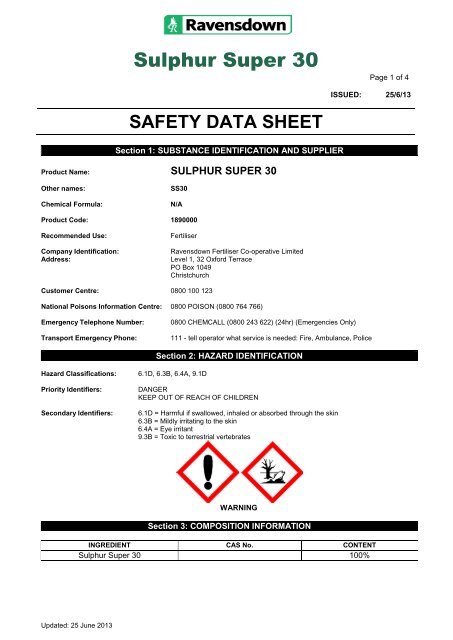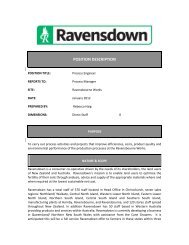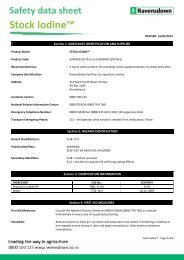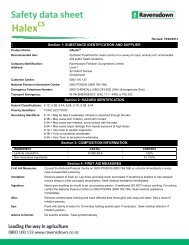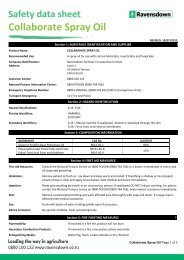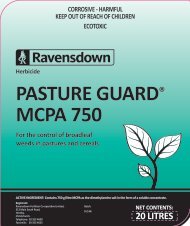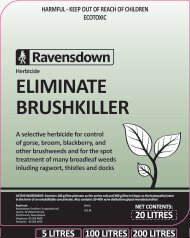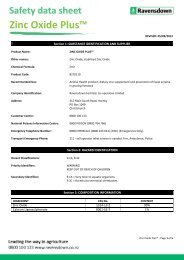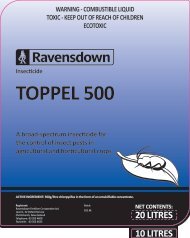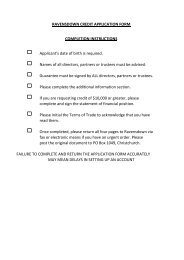Sulphur Super 30
Sulphur Super 30 safety data sheet - Ravensdown
Sulphur Super 30 safety data sheet - Ravensdown
- No tags were found...
You also want an ePaper? Increase the reach of your titles
YUMPU automatically turns print PDFs into web optimized ePapers that Google loves.
<strong>Sulphur</strong> <strong>Super</strong> <strong>30</strong>Page 1 of 4ISSUED: 25/6/13SAFETY DATA SHEETSection 1: SUBSTANCE IDENTIFICATION AND SUPPLIERProduct Name: SULPHUR SUPER <strong>30</strong>Other names:Chemical Formula:SS<strong>30</strong>N/AProduct Code: 1890000Recommended Use:Company Identification:Address:FertiliserRavensdown Fertiliser Co-operative LimitedLevel 1, 32 Oxford TerracePO Box 1049ChristchurchCustomer Centre: 0800 100 123National Poisons Information Centre: 0800 POISON (0800 764 766)Emergency Telephone Number:Transport Emergency Phone:0800 CHEMCALL (0800 243 622) (24hr) (Emergencies Only)111 - tell operator what service is needed: Fire, Ambulance, PoliceHazard Classifications: 6.1D, 6.3B, 6.4A, 9.1DSection 2: HAZARD IDENTIFICATIONPriority Identifiers:Secondary Identifiers:DANGERKEEP OUT OF REACH OF CHILDREN6.1D = Harmful if swallowed, inhaled or absorbed through the skin6.3B = Mildly irritating to the skin6.4A = Eye irritant9.3B = Toxic to terrestrial vertebratesWARNINGSection 3: COMPOSITION INFORMATIONINGREDIENT CAS No. CONTENT<strong>Sulphur</strong> <strong>Super</strong> <strong>30</strong> 100%Updated: 25 June 2013
<strong>Sulphur</strong> <strong>Super</strong> <strong>30</strong>Page 2 of 4Section 4: FIRST AID MEASURESFirst Aid Measures:Inhalation:Ingestion:Skin:Eye:Advice to Doctor:Consult the National Poisons Centre on 0800 POISON (0800 764 766) or a doctorimmediately in every case of suspected poisoning.Remove patient to fresh air. Lie down and keep warm and rested. If breathing is shallowor has stopped ensure airway is clear and apply resuscitation. Seek medical assistanceimmediately.Never give anything by mouth to an unconscious person. If swallowed rinse mouth butDO NOT induce vomiting. For advice, contact the National Poisons Centre on 0800POISON (0800 764 766). Seek medical assistance immediately.Remove contaminated clothing then wash affected area thoroughly with soap and water.If a large area is affected seek medical assistance. Wash contaminated clothing beforereuse.Flush with plenty of water for several minutes, holding eyelids open if necessary. Removecontact lenses if present and easy to do. Continue rinsing for at least 15 minutes. If eyeirritation persists seek medical assistance.No specific antidote. Treat symptomatically.Section 5: FIRE FIGHTING MEASURESFlash Point:Combustion Products:Extinguishing Media:Protective Equipment:HAZCHEM Code:N/A (Non-flammable)<strong>Sulphur</strong> oxides, metal oxides, phosphorous oxidesBased on surrounding materialsBreathing apparatus goggles and protective glovesNone allocated.Section 6: ACCIDENTAL RELEASE MEASURESSpills and Disposal:Wear appropriate protective clothing. Contain spill and sweep up. Collect and place insealable containers. Avoid generating dust. Reuse or recycle where possible.Protective Clothing: For appropriate personal protective equipment see section 8.EnvironmentalPrecaution:Avoid unintended release of excessive amounts into waterways or sewers. If spill doesenterwaterways contact local authority.Section 7: HANDLING AND STORAGEHandling:Storage:Other Information:Keep out of reach of children. Avoid generating dust. Use only outdoors or in wellventilatedareas. Do not breathe dust.Approved Handler: Not requiredTracking: Not requiredRecord Keeping: Not requiredStore in a cool, dry area away from oxidising agents and foodstuffs.Do not eat, drink or smoke while using this product. Wash hands thoroughly afterhandling. Avoid unintended release into the environment.Updated: 25 June 2013
<strong>Sulphur</strong> <strong>Super</strong> <strong>30</strong>Page 3 of 4Section 8: EXPOSURE CONTROL/PERSONAL PROTECTIONExposure Limits:Protective Equipment:Engineering Controls:Hygiene Precautions:Appearance:Odour:Specific Gravity:pH:Solubility in Water:Flash Point:Melting PointOther Information:Workplace Exposure Standards (WES): Particulates not otherwise classifiedInspirable dust 10mg.m -3Respirable dust 3mg.m -3Overalls, safety glasses and gloves. If dust is present wear dust mask and goggles. Eyewash facilities should be available.Handle in well ventilated area. If dust generated use local extraction to control. Avoidinhalation of dust.Do not eat, drink or smoke while using this product. Remove protective clothing and washhands and face before meals and after work. Wash protective clothing daily after work.Section 9: PHYSICAL AND CHEMICAL PROPERTIESGranular product. Colour varies with rock types from creamy to brown or dark greygranules. Yellow elemental sulphur may be visible.OdourlessNot AvailableNot AvailableSolubleN/AN/ANoneSection 10: STABILITY AND REACTIVITYStability:Hazardous Polymerisation:Hazardous DecompositionProducts:Conditions to Avoid:Materials to Avoid:Stable under normal conditions.Will not occur.<strong>Sulphur</strong> oxides, metal oxides, phosphorous oxides.No specific conditions.Oxidising agents.ERMA Classifications: 6.1D, 6.3B, 6.4ASection 11: TOXICOLOGICAL INFORMATIONIngestion:Inhalation:Skin:Eye:Chronic Effects:Other Information:Ingestion of large quantities may lead to nausea, vomiting, thirst and headache.Irritant. Over exposure may cause mucous membrane irritation and coughing.Irritant. Prolonged and repeated skin exposure may result in irritation, skin rash anddermatitis.Irritant. Direct contact may result in lachrymation (tears), pain, redness and conjunctivitis.Not anticipated.Low toxicity, no adverse health affects expected under normal conditions.Updated: 25 June 2013
<strong>Sulphur</strong> <strong>Super</strong> <strong>30</strong>Page 4 of 4ERMA Classifications: 9.1DSection 12: ECOLOGICAL INFORMATIONEcotoxicity:Avoid washing excessive amounts into streams and waterways. Avoid unintended releaseinto the environment.Section 13: DISPOSAL INFORMATIONProduct Disposal:Container Disposal:Collection into sealable containers and dispose of in an approved land fill. Reuse orrecycle where possible. If practicable apply excess fertiliser at recommended rates toappropriate land. Observe any local authority restrictions that may apply.Rinse containers thoroughly prior to reuse. Otherwise render unusable and dispose of aswaste.Section 14: TRANSPORT INFORMATIONUN Number:Proper Shipping Name:DG Class:UN Packing Group:Other Information:None Allocated.None Allocated.None Allocated.None Allocated.Not regulated for transport purposes.Section 15: REGULATORY INFORMATIONERMA:Approved pursuant to the HSNO Act 1996, Approval number HSR002571See www.erma.govt.nz for approval controls.Section 16: OTHER INFORMATIONThis SDS supersedes all previous versions and was reviewed to include HSNO requirements.The data in this SDS relates only to the specific material designated herein and does not relate to use in combination withany other material. The information is provided in good faith based on current knowledge and experience. No warrantywith regard to the product properties is expressed or implied.Updated: 25 June 2013


